LG Electronics Bundle
How Did a South Korean Radio Spark a Global Tech Giant: LG's Story?
Journey back to 1958, when LG Electronics, then known as Lak Hui Chemical Industrial Corp., laid its foundation in Busan, South Korea. This marked the beginning of the LG Electronics SWOT Analysis. From its inception, the company envisioned improving lives with innovative electronics, a vision that propelled it to the forefront of the global market.
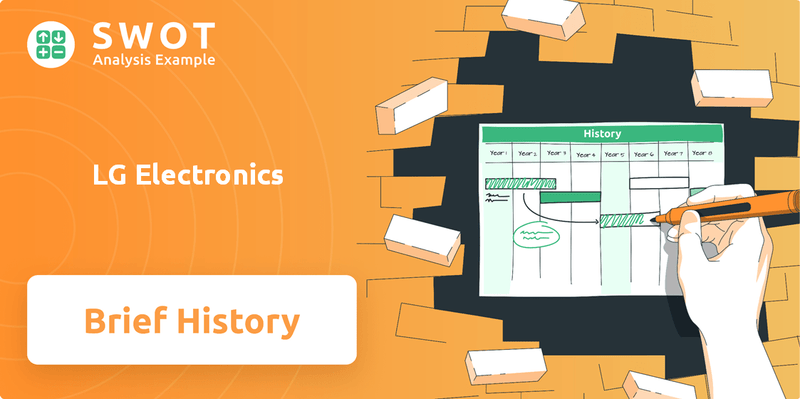
This brief history of LG Electronics explores the LG company's remarkable evolution, from its early years manufacturing radios to its current status as a global leader. Discover the key milestones and strategic decisions that have shaped the LG brand, including its impact on technology and its enduring legacy. The LG corporation's journey provides valuable insights into innovation, adaptability, and the relentless pursuit of excellence in the competitive landscape of consumer electronics and beyond, including LG products.
What is the LG Electronics Founding Story?
The brief history of LG Electronics begins on October 1, 1958, with the establishment of GoldStar Co., Ltd., a subsidiary of Lak Hui Chemical Industrial Corp. (Lucky Chemical Industrial Co.). This marked the inception of what would become a global technology leader, driven by a vision to meet the growing consumer electronics demand in post-Korean War South Korea. The company's early years were characterized by a focus on domestic production and innovation, setting the stage for its evolution into a major player in the global market.
The founder, Koo In-Hwoi, recognized the need for locally produced electronics to support national rebuilding and economic independence. GoldStar's initial focus was on manufacturing radios, addressing the limited access to these goods for the average Korean consumer due to import costs. This strategic move laid the foundation for the company's future expansion into various electronic products and technologies, establishing the LG history.
The company's first product, the A-501 radio, was released in 1959. This launch was a significant milestone, as it was South Korea's first domestically produced radio. The initial funding for GoldStar came from its parent company, Lucky Chemical Industrial Co. The 'Lucky' name was chosen to convey good fortune and prosperity, which resonated with the post-war rebuilding efforts. The cultural and economic context of the time, marked by a strong drive for industrialization and self-sufficiency in South Korea, significantly influenced the company's creation and its initial focus on essential consumer goods.
GoldStar Co., Ltd. was founded on October 1, 1958, as a subsidiary of Lucky Chemical Industrial Corp.
- Koo In-Hwoi, the founder, identified the growing demand for consumer electronics in post-war South Korea.
- The company's initial focus was on manufacturing radios, addressing the need for domestic production.
- The first product was the A-501 radio, South Korea's first domestically produced radio, released in 1959.
- The 'Lucky' name was chosen to convey good fortune, reflecting the post-war rebuilding efforts.
LG Electronics SWOT Analysis
- Complete SWOT Breakdown
- Fully Customizable
- Editable in Excel & Word
- Professional Formatting
- Investor-Ready Format
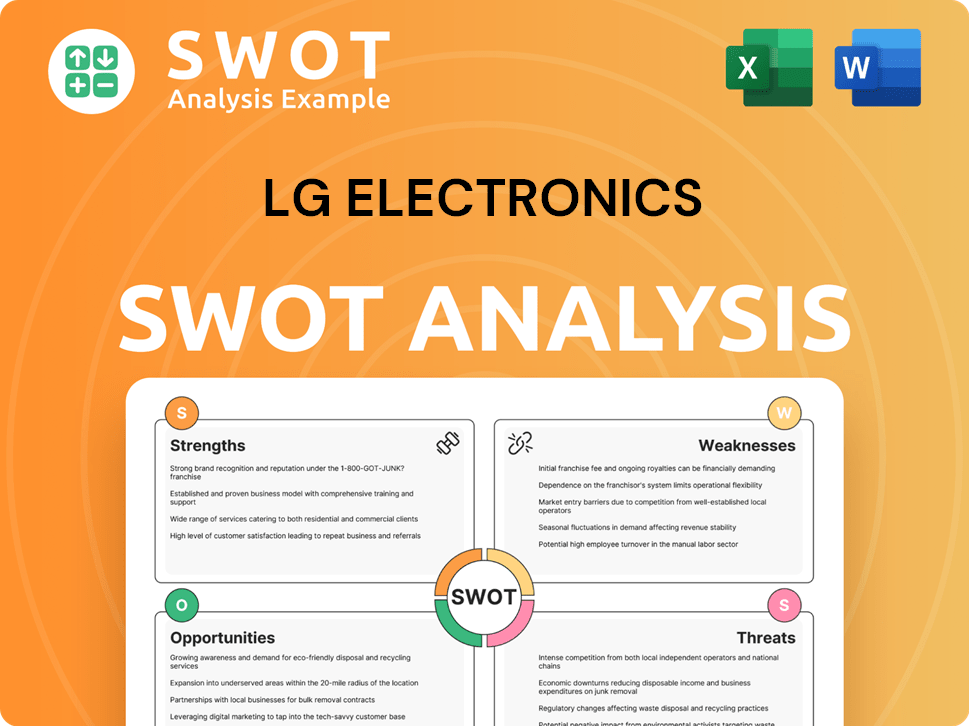
What Drove the Early Growth of LG Electronics?
The early growth of LG Electronics, then known as GoldStar, was marked by rapid expansion within South Korea. The company quickly diversified its product range after the success of its initial radio offerings. This period saw the introduction of various innovative products, solidifying GoldStar's position as a leading electronics manufacturer in the domestic market.
GoldStar's product portfolio expanded significantly during its early years. In 1960, it produced South Korea's first electric fan, followed by its first refrigerator in 1965. The company launched its first black-and-white television in 1966. This diversification was crucial for establishing the
To support its growing production, GoldStar expanded its team, focusing on engineering and manufacturing expertise. Early facilities were primarily located in Busan, later expanding to other industrial hubs. The introduction of washing machines in 1969 and air conditioners in 1968 further demonstrated its ambition to become a comprehensive home appliance provider.
A significant milestone was the establishment of GoldStar's first overseas branch in New York in 1968, marking its initial foray into international markets. This move signaled the company's broader ambitions beyond domestic dominance. The company continued its growth through the 1970s and 1980s, driven by increasing consumer demand and continuous product innovation.
During this period, GoldStar focused on improving manufacturing efficiency and expanding its research and development capabilities. Its products offered affordable alternatives to imported goods, maintaining a leading position in South Korea. The company's early mover advantage and consistent product quality helped it compete effectively in the evolving market.
LG Electronics PESTLE Analysis
- Covers All 6 PESTLE Categories
- No Research Needed – Save Hours of Work
- Built by Experts, Trusted by Consultants
- Instant Download, Ready to Use
- 100% Editable, Fully Customizable
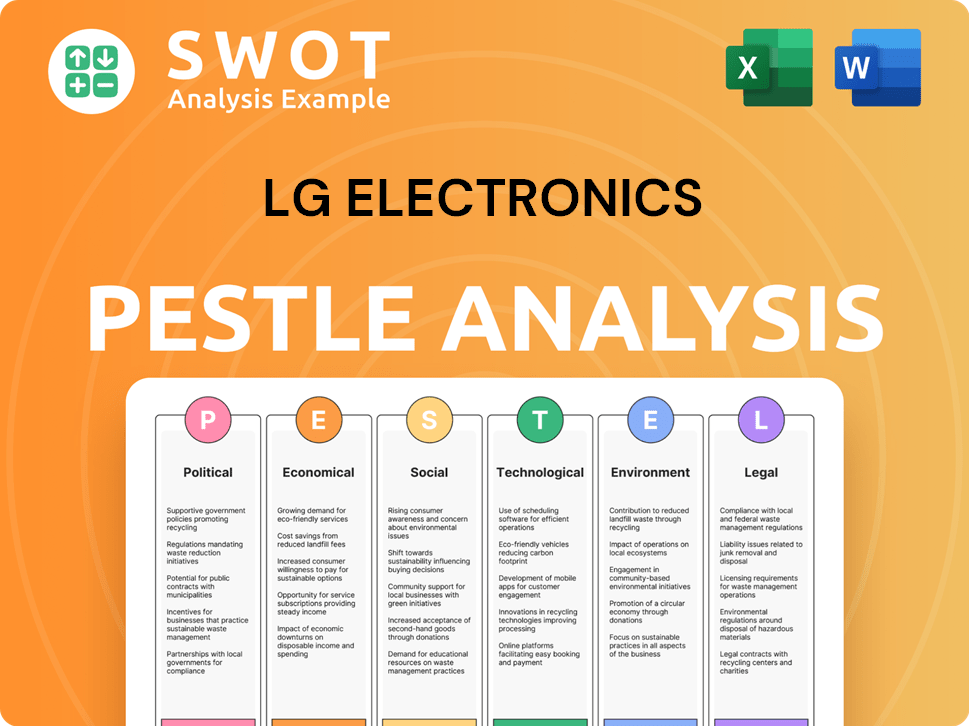
What are the key Milestones in LG Electronics history?
The LG Electronics, a prominent player in the global electronics market, boasts a rich history marked by significant milestones and transformations. From its early days as GoldStar to its current status as a diversified technology corporation, the company has continually adapted and innovated to stay competitive.
| Year | Milestone |
|---|---|
| 1993 | Introduced the world's first CD-ROM drive, showcasing early technological capabilities. |
| 1995 | GoldStar merged with Lucky Chemical and was rebranded as LG Electronics, unifying the corporate identity. |
| 1998 | Launched the world's first 60-inch plasma TV, marking a significant advancement in display technology. |
| 2000 | Introduced the first internet-enabled refrigerator, integrating technology into home appliances. |
| 2004 | Released the first 3G phone, keeping up with the mobile communication advancements. |
| 2021 | Exited the smartphone business, shifting focus to other profitable ventures. |
Throughout its history, LG Electronics has been at the forefront of technological advancements, consistently introducing innovative products and solutions. The company has secured numerous patents in display technology, mobile communications, and home appliances, which has solidified its reputation as a leader in innovation.
LG has been a pioneer in display technology, with innovations in OLED and LCD panels. They have consistently pushed the boundaries of picture quality and design, leading to premium TVs and monitors.
The company was an early adopter of 3G technology and has continued to innovate in mobile phones. Although it exited the smartphone market in 2021, its legacy in mobile technology remains.
LG has integrated smart technology into home appliances, such as refrigerators and washing machines. These innovations have improved convenience and efficiency for consumers.
Collaborations with companies like Google for smart TVs and Mercedes-Benz for automotive components have expanded its reach. These partnerships have helped LG diversify its product offerings.
LG has consistently received CES Innovation Awards, demonstrating its commitment to cutting-edge technology. These awards recognize the company's innovative products and designs.
LG has invested heavily in smart home solutions, including appliances and connected devices. This focus aligns with the growing demand for integrated and automated home systems.
Despite its successes, LG corporation has faced considerable challenges, including economic downturns and intense competition. The company's strategic decisions, such as exiting the smartphone market, reflect its ability to adapt to changing market dynamics.
The Asian financial crisis in the late 1990s presented significant economic challenges, requiring strategic restructuring. This period forced LG to implement cost-cutting measures and re-evaluate its business strategies.
Intense competition from Samsung and Apple in the mobile phone market led to struggles in market share and profitability. Despite innovative products, LG found it difficult to compete effectively.
The decision to exit the smartphone business in 2021 was a major strategic shift, reflecting the company's willingness to adapt. This move allowed LG to focus on more profitable ventures.
The electronics industry is subject to rapid technological changes and market fluctuations. LG must continually innovate to stay ahead of these challenges.
Global supply chain disruptions, particularly in recent years, have impacted manufacturing and distribution. LG has had to manage these challenges to maintain production.
Geopolitical events and trade policies can affect international business operations. LG must navigate these factors to maintain its global presence and competitiveness.
LG Electronics Business Model Canvas
- Complete 9-Block Business Model Canvas
- Effortlessly Communicate Your Business Strategy
- Investor-Ready BMC Format
- 100% Editable and Customizable
- Clear and Structured Layout
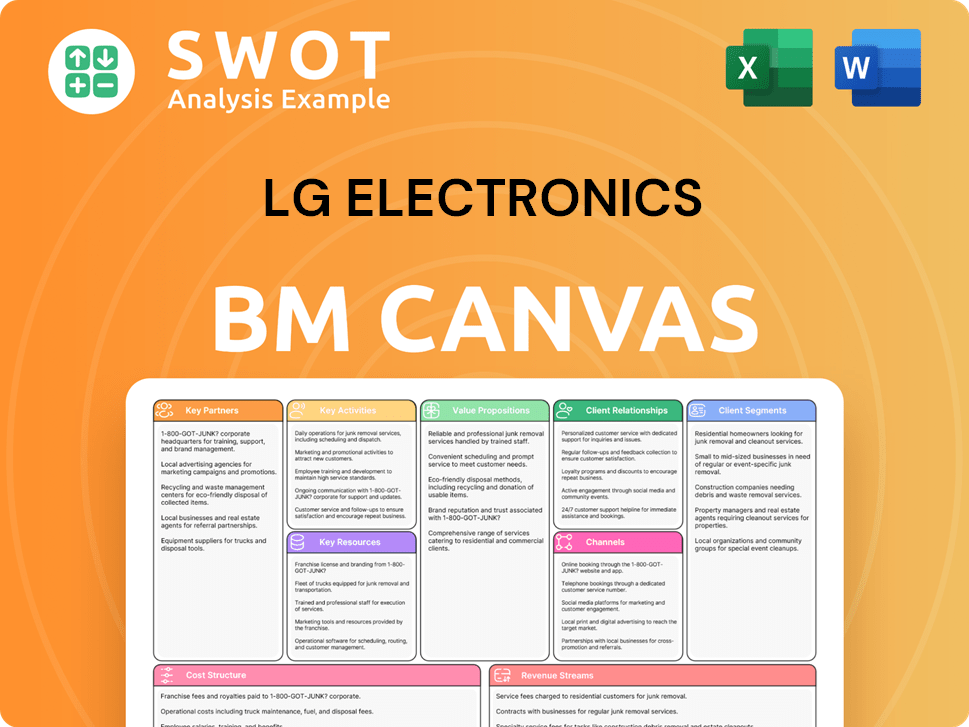
What is the Timeline of Key Events for LG Electronics?
The LG Electronics journey, a story of innovation and expansion, began in 1958 with the founding of GoldStar Co., Ltd. This marked the start of a remarkable evolution, from producing South Korea's first radio to becoming a global technology leader. The LG history is filled with milestones, including pioneering advancements in home appliances and consumer electronics, and strategic moves to establish a strong global presence. The LG company has consistently adapted to changing market dynamics, embracing new technologies and expanding its business horizons.
| Year | Key Event |
|---|---|
| 1958 | GoldStar Co., Ltd. was founded, producing South Korea's first radio. |
| 1965 | Produced South Korea's first refrigerator. |
| 1966 | Produced South Korea's first black-and-white television. |
| 1968 | Established its first overseas branch in New York. |
| 1973 | Became the first South Korean company to export color televisions. |
| 1982 | Established its first overseas production base in Huntsville, Alabama, USA. |
| 1995 | GoldStar officially merged with Lucky Chemical and rebranded as LG Electronics. |
| 1998 | Introduced the world's first 60-inch plasma TV. |
| 2000 | Introduced the world's first internet-enabled refrigerator. |
| 2004 | Launched the world's first 3G phone. |
| 2007 | Introduced the first full HD LCD TV. |
| 2013 | Launched the first curved OLED TV. |
| 2021 | Exited the smartphone business to focus on other growth areas. |
| 2024 | LG continues to invest heavily in AI, robotics, and electric vehicle components, with a focus on smart home solutions. |
LG is heavily investing in artificial intelligence (AI) and robotics. This includes integrating AI across its product lines, from home appliances to commercial displays. The company's focus is on creating more intelligent and automated solutions. This strategic direction aligns with the increasing demand for smart and connected devices in the market.
LG is expanding its presence in the electric vehicle (EV) components market. This involves leveraging its expertise in batteries, displays, and connectivity solutions. The EV market is experiencing significant growth, and LG aims to capitalize on this trend. This move supports the company's diversification strategy and its commitment to sustainable technologies.
Smart home solutions remain a core strategic initiative for LG. The company is focused on creating a seamlessly connected ecosystem of devices. This includes integrating its products with various smart home platforms. The goal is to enhance user experience and provide more personalized and connected experiences.
Analyst predictions suggest a strong emphasis on B2B solutions and services. This includes expanding its offerings in commercial displays, digital signage, and other business-oriented products. This strategic move aims to diversify revenue streams and reduce reliance on the consumer electronics market. The company is likely to focus on providing integrated solutions for various industries.
LG Electronics Porter's Five Forces Analysis
- Covers All 5 Competitive Forces in Detail
- Structured for Consultants, Students, and Founders
- 100% Editable in Microsoft Word & Excel
- Instant Digital Download – Use Immediately
- Compatible with Mac & PC – Fully Unlocked
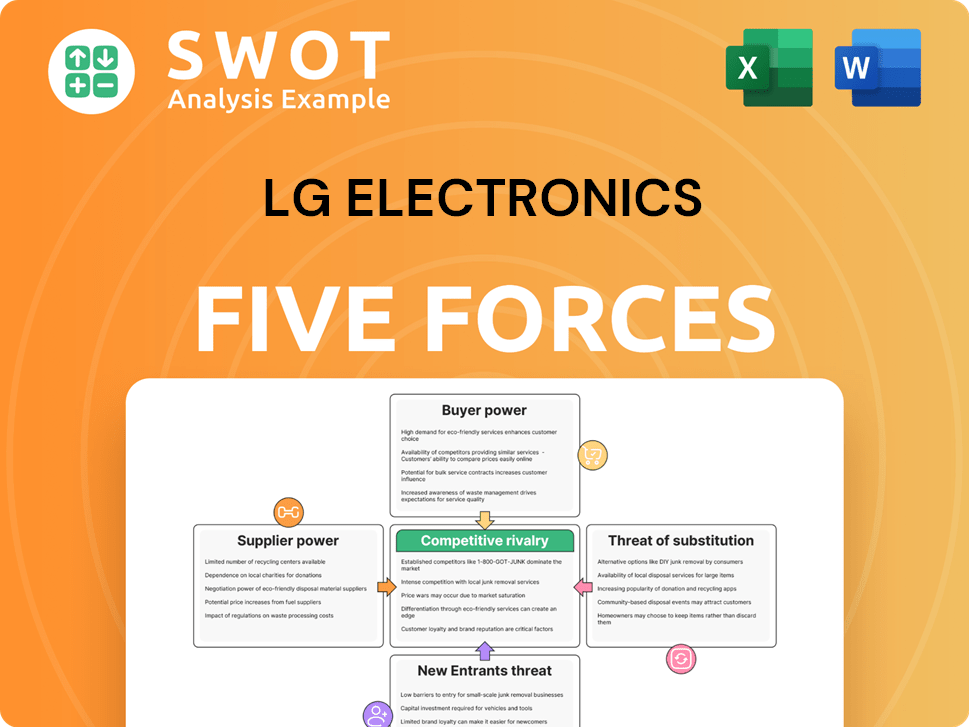
Related Blogs
- What is Competitive Landscape of LG Electronics Company?
- What is Growth Strategy and Future Prospects of LG Electronics Company?
- How Does LG Electronics Company Work?
- What is Sales and Marketing Strategy of LG Electronics Company?
- What is Brief History of LG Electronics Company?
- Who Owns LG Electronics Company?
- What is Customer Demographics and Target Market of LG Electronics Company?
Disclaimer
All information, articles, and product details provided on this website are for general informational and educational purposes only. We do not claim any ownership over, nor do we intend to infringe upon, any trademarks, copyrights, logos, brand names, or other intellectual property mentioned or depicted on this site. Such intellectual property remains the property of its respective owners, and any references here are made solely for identification or informational purposes, without implying any affiliation, endorsement, or partnership.
We make no representations or warranties, express or implied, regarding the accuracy, completeness, or suitability of any content or products presented. Nothing on this website should be construed as legal, tax, investment, financial, medical, or other professional advice. In addition, no part of this site—including articles or product references—constitutes a solicitation, recommendation, endorsement, advertisement, or offer to buy or sell any securities, franchises, or other financial instruments, particularly in jurisdictions where such activity would be unlawful.
All content is of a general nature and may not address the specific circumstances of any individual or entity. It is not a substitute for professional advice or services. Any actions you take based on the information provided here are strictly at your own risk. You accept full responsibility for any decisions or outcomes arising from your use of this website and agree to release us from any liability in connection with your use of, or reliance upon, the content or products found herein.